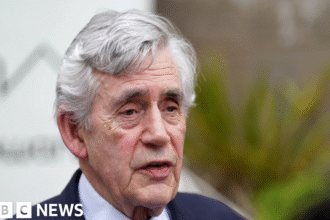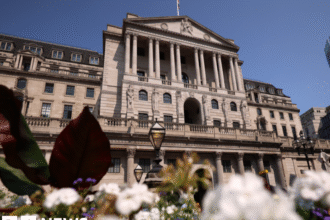US President Donald Trump’s sweeping new tariffs on countries around the world have come into effect in an escalation of his trade war.
“IT’S MIDNIGHT!!! BILLIONS OF DOLLARS IN TARIFFS ARE NOW FLOWING INTO THE UNITED STATES OF AMERICA!” he said on social media minutes before midnight in Washington, DC.
Also on Wednesday, Trump hit India with a 50% tariff on its goods, which will take effect on 27 August unless it stops buying Russian oil.
Trump also threatened a 100% tariff on foreign-made computer chips as he pushes tech firms to invest in the US. It came as Apple announced a new $100bn US investment (£75bn) after coming under pressure from the president to move more production to America.
Last week, the White House announced a revised list of import taxes on dozens of trading partners and extended a deadline for countries to reach deals with the US to 7 August.
Countries have been racing to strike deals with Washington to lower – or scrap – what Trump calls “reciprocal tariffs”.
His trade policies are aimed at reshaping the global trading system, which he sees as treating the US unfairly.
Export-dependent economies in South East Asia were among the hardest-hit by Trump’s tariffs.
Manufacturing-focused Laos and Myanmar faced some of the highest levies at 40%. Some experts said Trump appears to have targeted countries with close trade ties with China.
Some major economies – including the UK, Japan and South Korea – have already reached agreements to get lower tariffs than Trump threatened to impose on them.
The European Union has also struck a framework deal with Washington, in which Brussels has accepted a 15% tariff on the the trading bloc.
Taiwan, a key Washington ally in Asia, was handed a 20% tariff. Its president Lai Ching-te said the rate is “temporary” and that talks with the US are still underway.
Last week, Trump boosted the tariff rate on Canada from 25% to 35%, saying the country had “failed to cooperate” in curbing the flow of fentanyl and other drugs across the US border. The Canadian government says it is cracking down on drug gangs.
But most goods Canadian exports to the US will dodge the import tax due to an existing trade treaty, the United States-Mexico-Canada Agreement (USMCA).
Higher tariffs on Mexico were paused for another 90 days as negotiations continue to strike a trade deal.
On Wednesday, Trump’s said he would impose a 100% tariff on foreign-made semiconductors.
Major chipmakers that have made significant investments in the US appear to have dodged the new tariff. Government officials in Taiwan and South Korea have said in separate statements that TSMC, SK Hynix, and Samsung would be exempt from the new levy.
The White House did not immediately respond to a BBC request for clarification.
The BBC has also contacted SK Hynix and Samsung. TSMC declined to comment.
Also on Wednesday, Trump raised the total tariff on India to 50% as he pushes the world’s third largest importer of energy to stop buying oil from Russia.
New Delhi has called the move “unfair, unjustified and unreasonable” and vowed to protect its national interests.
Brazil’s exports to the US also face a 50% tariff. Trump imposed the levy after accusing President Luiz Inacio Lula da Silva of unfairly attacking US technology firms and calling the prosecution of former President Jair Bolsonaro for allegedly attempting a coup a “witch hunt”.
The US and China have held a series of talks as they tried to agree an extension to a 90-day tariffs pause that is due to expire on 12 August.






